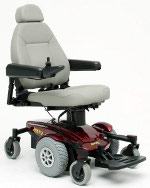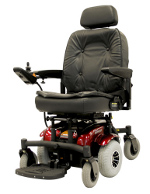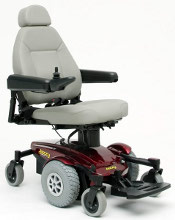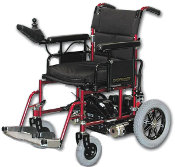The Wheelchair Guide
Your Wheelchair and Mobility Scooter Resource
Electric Wheelchairs of Today and Yesterday
Sunday, July 19th, 2009
 Today, electric wheelchairs are essential mobility vehicles, used by millions of people all over the world. Electric wheelchairs have changed a great deal over the last fifty years and remain incredibly popular, especially among those who are unable to use a manual wheelchair.
Today, electric wheelchairs are essential mobility vehicles, used by millions of people all over the world. Electric wheelchairs have changed a great deal over the last fifty years and remain incredibly popular, especially among those who are unable to use a manual wheelchair.
When electric wheelchairs, or power chairs, were first invented, an electric motor was placed onto a manual wheelchair, allowing it to be controlled electronically. This was a major improvement, which greatly increased the accessibility of those who were otherwise unable to get around by themselves. A number of companies quickly formed to sell these manual wheelchair converter kits, which were usually based off of the E & J Wheelchair.
While it is still possible to buy manual wheelchair converter kits, most electric wheelchairs today consist of a molded plastic base, which contains the electronic components of the wheelchair, with a large comfortable chair fitted onto the base. As a result, most modern electric wheelchairs can not be reverted into a manual wheelchair should the battery die, but they are much more powerful and often include a lot of neat features.
Most electric wheelchairs are controlled by using a simple joystick, which is secured to the arm of the chair. The joystick can be configured for left hand or right hand use, which is typically done by the manufacturer, although it is typically possible for the user to change this as well. In addition to the joystick, a simple throttle, which controls the speed of the wheelchair, is also usually on the arm of the chair. For those who are not able to use the standard wheelchair control, alternative controls are also available.
Many of todays electric wheelchairs share a number of similarities, both in the way they are designed, as well as the way they look. Typically, electric wheelchairs are classified by the type of drive system, either mid-wheel drive or rear wheel drive, as well as by how easy it is to transport the wheelchair.
In a mid-wheel drive electric wheelchair, the base of the wheelchair will typically have three rows of wheels. The middle row is the row that is responsible for moving and turning the wheelchair, while the other two rows help provide support. A mid-wheel drive system is extremely maneuverable, which makes it great for indoor use. In a rear wheel drive wheelchair, there will usually only be two rows of wheels, with the rear wheels being responsible for moving and turning. While not quite as maneuverable as a mid-wheel drive wheelchair, a rear wheel drive wheelchair does provide a little bit more stability because the weight is more evenly distributed between the base of the chair.
The other way that power chairs are classified is by how easy it is to transport them. Travel wheelchairs are available, which are designed to be taken apart to make it easier for them to be transported in a vehicle. There are even some folding electric wheelchairs, which closely resemble the design of a manual wheelchair. If you do not have a travel wheelchair, you will likely need a wheelchair lift to transport the device in a vehicle. This is because even though most electric wheelchairs can be disassembled, the individual pieces of a non-travel wheelchair can be very heavy.
The electric wheelchair has come a long way over the last fifty years and is today a very important tool for millions of people all across the World.
Electric Wheelchairs
Thursday, June 4th, 2009
The wheelchair is one of the oldest types of medical equipment known to man. Its uses can be traced back thousands of years and every year, the wheelchair greatly improves the lives of the mobility challenged. The electric wheelchair, on the other hand, is a much newer device and has only been available for about sixty years.
The first electric wheelchairs, which were developed during the nineteen-fifties, were simply manual wheelchairs that had been outfitted with an electric motor. They have changed a great deal since then, although there are a few that still share a similar design to these early electric wheelchairs. Most however, have a power base, which contains the electric motor, wheels, and batteries, with a chair mounted to the top of the base.
To control the wheelchair, a simple joystick is attached to the arm of the chair and the wheelchair user can simply push the joystick in the direction they wish to go. Most will also have a button for a horn, a battery meter, and a speed adjustment mounted in the armrest.
While for many people the joystick will provide an adequate control system, there are some who lack the ability to use this type of control and must instead use an alternate wheelchair control system. For instance, it is possible to control the wheelchair with head movements, breath, or even with a remote control. Currently, there are several companies working on a brain controlled wheelchair as well, which will eventually allow the wheelchair user to control their wheelchair with thoughts.
There are many different models of electric wheelchair available and a number of different manufacturers as well, but most electric wheelchairs can usually be classified as either rear wheel drive wheelchairs or mid-wheel drive wheelchairs.
A rear wheel drive wheelchair usually has 4 wheels and the two rear wheels are responsible for moving the wheelchair. They provide a very sturdy and stable base, because the weight is evenly distributed across the four wheels.
A mid-wheel drive wheelchair usually has 6 wheels. The set of wheels in the middle is used to move the wheelchair and the other wheels, which are located on the front and back of the base, are used to provide stability. A mid-wheel drive wheelchair is incredibly maneuverable, however the weight is not as evenly distributed, so it will not be as stable as a rear wheel drive wheelchair.
While the rear wheel and mid-wheel drive wheelchairs are the most common, there are also foldable electric wheelchairs, which use a frame that is similar to that of a manual wheelchair. These are popular for traveling, but lack many of the features of the other types of electric wheelchairs.
The electric wheelchair has greatly evolved over the last fifty years and today provides a very reliable and dependable way to allow a mobility challenged individual to get around.
Medicare and Electric Wheelchairs
Wednesday, May 27th, 2009
Medicare is a federally funded insurance program available to most Americans over the age of sixty-five. It is designed to provide affordable health care and covers the cost of doctors visits and prescriptions. In addition to providing coverage similar to that of private insurance, Medicare also covers the cost of Durable Medical Equipment, which is a broad category consisting of many types of home medical equipment.
Wheelchairs, both manual and electric, fall into the category of Durable Medical Equipment and are typically covered by Medicare.
While electric wheelchairs are covered by Medicare, the insured must meet several requirements in order for the device to be covered. One of the main requirements is that the individual is unable to use a manual wheelchair. They must also be able to transfer into and out of the wheelchair and able to operate the electric wheelchair in a safe manner.
In addition to the above physical requirements, the electric wheelchair must also be prescribed by a doctor as part of a treatment plan. In most cases, Medicare will only cover one electric wheelchair every five years, so if they have previously provided reimbursement for a wheelchair, it might not be available.
With a doctors prescription and assuming the insured meets the other physical requirements, Medicare will typically provide reimbursement for up to 80% of the cost of an electric wheelchair. Some companies will directly bill Medicare, although it is usually also possible to buy the electric wheelchair first and apply for reimbursement later. However, if you go this route ensure that you meet Medicare’s requirements first and will be eligible to receive reimbursement.
For those who use a Medicare Advantage Plan (MMA) the rules for reimbursement may vary, so it will be necessary to check with the company that runs this plan. A Medicare Advantage Plan is available to those eligible for Medicare and covers the same things as traditional Medicare, but is run by a private insurance company. As a result, the way some things are covered and reimbursement received can be a little bit different, but Medicare Advantage Plans are required to cover the same things as traditional Medicare.
Electric Wheelchairs for Seniors
Thursday, May 21st, 2009
 Electric wheelchairs, which are often also called power chairs, offer the advantage of a manual wheelchair, in that they are very maneuverable. However, unlike manual wheelchairs, power chairs are powered electronically, so they can typically be operated very easily, requiring very little physical activity of the senior.
Electric wheelchairs, which are often also called power chairs, offer the advantage of a manual wheelchair, in that they are very maneuverable. However, unlike manual wheelchairs, power chairs are powered electronically, so they can typically be operated very easily, requiring very little physical activity of the senior.
A simple joystick control scheme is most popular for controlling electric wheelchairs, which allows the senior to simply push the joystick. The joystick, which is attached to the arm of the power chair, then moves the wheelchair in the direction they wish to travel. Of course, there are a number of alternate wheelchair control systems available as well, including breath controlled systems and remote controlled systems, which are often used by caretakers.
A Brief Background on Electric Wheelchairs
The first electric wheelchairs, which were developed in the early 1950′s, were simply adapted E & J manual wheelchairs.
An electric motor was attached to the manual wheelchair, which was controlled using a simple joystick control scheme, although even during the 1950′s, researchers were already coming up with alternate control schemes. One popular method was to mount something similar to a joystick near the individuals head. They could then use their face to control the electric wheelchair.
The Modern Electric Wheelchair
Today, while some portable electric wheelchairs do use a traditional steel tubed folding wheelchair design, most look much different from a traditional manual wheelchair. Instead, an electric motor and battery is contained in the base of the wheelchair, usually covered by molded plastic.
A captains chair, which, depending on the cost of the power chair, often rivals that of most office chairs, both in comfort and durability, is mounted on the base of the wheelchair. The captains chair often reclines and swivels, to facilitate comfort and make transferring into and out of the wheelchair easier. Some even include an electric lifting system to raise and lower the chair.
While many power chairs share a similar design, one way they are often classified is by their wheels. A mid-wheel power chair features one set of large wheels in the middle of the base and one set of smaller wheels on the front and back of the base. The larger wheels are what does all of the work and are powered by the electric motor. The smaller set of wheels on either side of the drive wheels, provide extra support and stability.
The mid-wheel electric wheelchair offers the advantage of excellent maneuverability. It can turn in much smaller spaces. However, in some cases it might not offer the same stability as a rear-wheel drive wheelchair. This is because the center of balance for a mid-wheel wheelchair is in the middle of the power chairs base.
The other common type of electric power chair is the rear wheel drive wheelchair. These feature a set of rear wheels, which depending on the model might be slightly larger, and a set of front wheels, giving it four wheels in total. The rear wheels, are powered and what actually moves the power chair.
The rear wheel drive wheelchair does not offer the same maneuverability that a mid-wheel power chair does, but does offer increased stability. This is because the weight of the occupant is more evenly distributed across the base, making a wider center of balance.
As is the case with manual wheelchairs, power chairs, both mid-wheel and rear wheel drive models, include anti-tip casters to prevent the wheelchair from tipping over backwards.
Advantages of Electric Wheelchairs
One of the major advantages that an electric wheelchair offers is that it does not require much effort to use. Simply push the joystick and the power chair will move, with many offer very small turning radius and sensitive controls. The speed is often adjustable and some models can reach speeds of over 10 miles per hour.
The range of a power chair varies, but most can travel at least 5 miles without requring a recharge. Some can travel upwards of 20 or 30 miles per charge, but this often is dependent on the terrain and weight of the occupant. For example, if you decided to drive around the hills of San Fransisco, the battery would wear down much quicker than it would when used on flat land.
Along the same lines, if the rider weighed 300 pounds, the battery would wear down quicker than if they weighed 150 pounds. Often, an extra battery pack is purchased for those who use the power chair continuously, as this way when one battery pack wears down, it can be removed and charged, and the fresh battery pack used.
Electric Wheelchairs and Seniors
While the electric power chair can be an excellent device, especially for seniors, it is often cost prohibitive.
Of the three main mobility options, manual wheelchairs, electric wheelchairs, and mobility scooters, electric wheelchairs are by far the most expensive. When compared to mobility scooters, electric wheelchairs often also have a lower range, lower top speed, and are not as well suited to rough terrain. However, for indoor use, they are usually superior to scooters.
Electric Power Wheelchairs: An Introduction
Wednesday, April 29th, 2009
 The electric wheelchair is today very popular and has been around since the early 1950′s. Early electric wheelchairs simply used the frame of a manual wheelchair and added an electric motor to it. Unlike manual wheelchairs, which require a great deal of upper body strength to use, electric wheelchairs require virtually no effort on the part of the user. They are also often referred to as power chairs or electric power chairs.
The electric wheelchair is today very popular and has been around since the early 1950′s. Early electric wheelchairs simply used the frame of a manual wheelchair and added an electric motor to it. Unlike manual wheelchairs, which require a great deal of upper body strength to use, electric wheelchairs require virtually no effort on the part of the user. They are also often referred to as power chairs or electric power chairs.
Today, some models are still available that use a traditional manual wheelchair design, but most make use of a molded plastic base, which contains the electric motor. One or more batteries is also contained in the base of the electric wheelchair, which allows it to be used over great distances.
The range and top speed of an electric wheelchair varies by model, but most are able to at least travel 5 miles on a single charge and at speeds of around 4 mph. The weight capacity of electric wheelchairs varies by model, but 250 pounds is almost an industry standard.
The chair of the electric wheelchair in some regards resembles an office chair, with a high back and armrests on either side. It includes a good deal of padding and can be reclined. It also usually swivels to the left or right, allowing for the power chair to be exited in a safe manner. The chair, which is often called the Captain’s Chair, usually has foldable armrests to further facilitate smooth transfers into and out of the chair. Some even have an electrical lifting system, which raises and lowers the chair. This can be important if, for example, using a table that is higher than normal.
Electric Wheelchair Control Systems
Most power chairs use a joystick control that is mounted to the armrest of the chair. This design is the same used on the first electric wheelchairs and can be configured for use on the left or right side of the power chair. There are also a number of alternate controls available for those who are not able to operate the joystick.
Perhaps the most common alternate wheelchair control allows the wheelchair to be controlled by the users breath. Blowing into the wheelchair moves it forward and breathing in moves it backwards. The direction of the wheelchair can also be controlled. There are a number of other alternate controls, including a remote control that can be operated by a caretaker.
Portable Power Chairs
 If you want to transport a traditional power chair, it is usually necessary to use a wheelchair lift. However, portable power chairs are available, which are lightweight and can be folded to take up less space. These models closely resemble a manual wheelchair, with a steel or aluminum frame and cloth seat. However, they still weigh a great deal more than a manual wheelchair would.
If you want to transport a traditional power chair, it is usually necessary to use a wheelchair lift. However, portable power chairs are available, which are lightweight and can be folded to take up less space. These models closely resemble a manual wheelchair, with a steel or aluminum frame and cloth seat. However, they still weigh a great deal more than a manual wheelchair would.
The motor and battery is installed under the seat and while these units often do not have as far of a range as other power chairs, they are easier to transport.
New ISO Standard for Electric Wheelchairs
Monday, November 10th, 2008
Wheelchairs today offer increased mobility to people all over the world. Even in only the last ten years, there have been many improvements to the design and reliability of the electric wheelchair, but there are still many areas, both around the home and away, that can present an obstacle to a person using a wheelchair. In an effort to help make choosing a wheelchair based on its abilities to navigate these types of obstacles easier, a new ISO standard was recently released.
This ISO standard, ISO 7176-10:2008, is the tenth part of a of an ISO that deals with wheelchairs. Specifically, this new standard is aimed at determining the ability of an electric wheelchair, or power chair, to climb or descend obstacles. This includes curbs, doorways, uneven pavement, and other obstacles that an individual might encounter. It presents a set of test procedures to use, describes the type of equipment required to preform tests, and how to evaluate the findings.
It is hoped that with the adoption of this standard, the consumer will be able to better rate different wheelchairs and find one that specifically meets their needs. This rating will better reflect not only the overall ability of the wheelchair, but also how adept it is at driving over obstacles.
The International Organization of Standardization, or ISO, is an organization that is represented by individuals from across the world. They meet to create international standards and specifications for many types of products, including health and disability related products. Even though the organization is itself not directly tied to the government, many of their standards end up being turned into law.
The ISO 7176 is a series on wheelchairs prepared by a group of professionals and researchers of Assistive products and how these devices can be used by people in wheelchairs. It help provides a method of classifying wheelchairs based on factors like their size, weight, maneuverability, energy usage, ease of control, acceleration, overall strength, crash resistance, quality of brakes, and speed.
Wheelchair Controls and BCI
Monday, November 10th, 2008
The first electric wheelchair was invented in the fifties. This chair made use of a simple control stick that could be mounted to either side of the chair. This allowed the chairs occupant to control the movement of the wheelchair using little more than a finger. This control setup is still very common, but, as the inventors in the fifties quickly realized, many people cannot use the joystick system.
Alternative control methods were developed almost as soon as the electric wheelchair was created. Several different control schemes were created, but the most common utilized head movement to control the wheelchairs.
There are many different control setups that are used today, including several that utilize head movements. One of the most common types of alternate wheelchair control uses the breath of the user to control the chair. The occupant will blow or suck through a small straw, which controls the wheelchair.
Several different wheelchair control systems are currently in the development stage, which use computers to control the chair. One uses voice recognition software to control the chair, while another uses a small magnet that is stuck to the riders tongue. A special headset picks up the movements of the magnet and sends them to a computer.
Recently, thought controlled computers have begun to be experimented with. This is commonly referred to as a brain-computer interface (BCI.) The development of a BCI actually began in the seventies, but it wasn’t until the middle of the nineties that an actual working prototype was built.
A brain-computer interface offers two different services. It can allow an individual to interact with a computer or it can be used to help trigger nerves and possible facilitate movement. In the terms of wheelchair control, the ability to interact with the computer is of most importance, but being able to have the computer signal back if there is an object in the way, could also be extremely beneficial.
In regards to wheelchairs, this technology offers many exciting applications. Computer controlled wheelchairs are currently available and being developed. These machines can be for the most part completely controlled by a laptop, so using BCI, an individual will eventually be able to control their wheelchair with only a thought.
There are two main types of Brain Controlled Interfaces: Invasive and non-invasive. Invasive BCI, involves physically implanting an electrode into the brain. These offer the clearest signal, but pose a health risk, as sometimes the area will scar or weaken. There are also a less invasive version that implants electrodes into the head, but not into the brain. This improves signal, but reduces the risk of irritating the brain.
Non-invasive BCIs are more common today. A user will wear a piece of headgear that is covered in electrodes. The signal is weaker, but it is currently safer to use in this manner.
Brain Controlled Computers will likely play a big part in rehabilitation treatment in the future. Several studies and commercial ventures are currently taking part in research and development of BCI. There are several systems available that allow a user to control a computer with their mind and thereby allowing them to speak and communicate their thoughts.